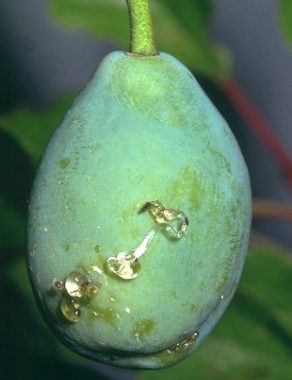
Polillas
WHAT IS AND HOW TO ELIMINATE
Carpocapsa
Cydia Pomonella
Pathogen:
Insect
Type:
Risk to the plant:
CRITICAL



DESCRIPTION
WHO CAUSES IT?
Cydia pomonella, commonly known as the codling moth, is an insect that belongs to the Tortricidae family. Adults are small moths approximately 10 mm long with gray wings and dark transverse bands. The eggs, oval in shape and creamy white in color, are laid individually on or near the fruits. Once the eggs hatch, the larvae emerge and begin boring into the fruit in search of seeds, causing significant damage. These larvae are creamy white with a dark brown head and go through five larval instars before leaving the fruit to pupate in the soil or in cracks in the tree bark. Pupation occurs in a silk cocoon, where the larvae overwinter. In spring, they emerge as adults ready to start a new cycle. The development of Cydia pomonella is highly influenced by temperature, with one or two generations per year depending on the climate.
SYMPTOMS
Codling moth causes serious damage to plums, compromising both the quality and quantity of the harvest. The larvae feed on the inside of the fruit, resulting in premature fruit drop and decay. The presence of larvae also facilitates the entry of other pathogens, which aggravates the damage.
- Entry and exit holes in the fruits.
- Presence of excrement and sawdust at the entry point.
- Premature fall of infested fruits.
- Internal damage to the fruits, with tunnels that lead to the seeds.
- Decomposition and rotting of affected fruits.
- Loss of commercial quality of the fruit.
- Significant reduction in total production.



TEMPERATURE AND HUMIDITY
20-30°C
60-80%

HOW IS IT SPREAD?
Wind, movement of infected fruits, contaminated agricultural tools, nursery material, direct contact between plants

HOW TO REMOVE IT?
Home remedies
There are no home treatments
Chemical treatments
• ACETAMIPRID 20% [SL] P/V
• CYDIA POMONELLA ATTRACTANT (Cairomonal attractant)
• CHLORANTRANILIPROL 20% [SC] P/V
• Cydia pomonella (Pheromone)
• DELTAMETHRIN 1.5% [EW] P/V
• DELTAMETHRIN 1.57% [SC] P/V
• DELTAMETHRIN 10% [EC] P/V
• DELTAMETHRIN 2.5% [EC] P/V
• DELTAMETHRIN 2.5% [EW] P/V
• EMAMECTIN BENZOATE 0.95% [WG] P/P
• LAMBDA CYHALOTHRIN 1.5% [CS] P/V
• LAMBDA CYHALOTHRIN 10% [CS] P/V
• LAMBDA CYHALOTHRIN 2.5% [WG] P/P
• SPINETORAM 25% [WG] P/P
• SPINOSAD 48% [SC] P/V
Authorized treatments in organic farming
• CYDIA POMONELLA ATTRACTANT (Cairomonal attractant)
• Cydia pomonella (Pheromone)
• LAMBDA CYHALOTHRIN 1.5% [CS] P/V
• LAMBDA CYHALOTHRIN 10% [CS] P/V
• LAMBDA CYHALOTHRIN 2.5% [WG] P/P
• SPINOSAD 48% [SC] P/V
Insect allies
EFFECTIVE PRODUCTS TO ELIMINATE THIS PEST
Sponsored link
Sponsored link
Sponsored link
Sponsored link
Sponsored link
Sponsored link
Effective against all types of fungi
- Regularly monitor crops using pheromone traps to detect the presence of adults.
- Implement biological control techniques using natural enemies such as Trichogramma spp.
- Apply treatments with selective insecticides at critical moments of pest development.
- Carry out sanitation practices, eliminating and destroying fallen and damaged fruits.
- Maintain hygiene in the garden, eliminating plant debris and waste where larvae can take refuge.
- Use protective nets or bags around the fruits to prevent oviposition.
- Promote the use of varieties that are resistant or less susceptible to infestation.
- Carry out a crop rotation to interrupt the life cycle of the pest.
- Apply sexual confusion treatments with pheromones to reduce moth mating.
- Promote a favorable environment for the natural predators of the codling moth through the diversity of plants in the garden.




















